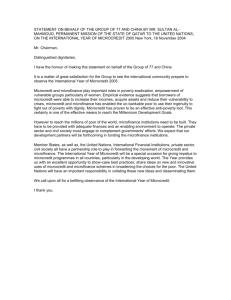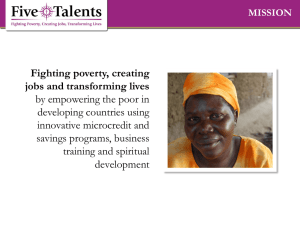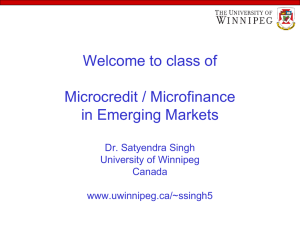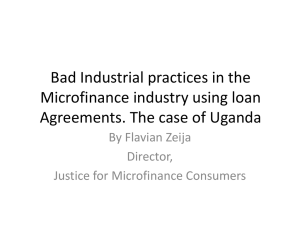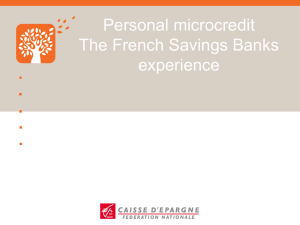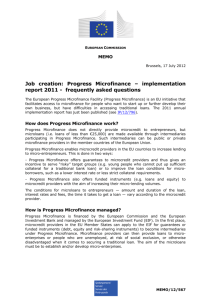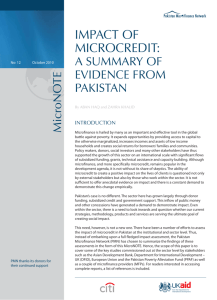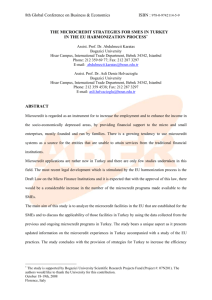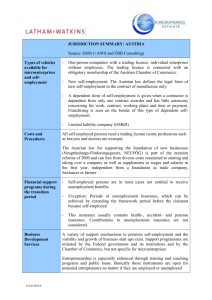Microcredit_role_in_sustainable_development_and
advertisement
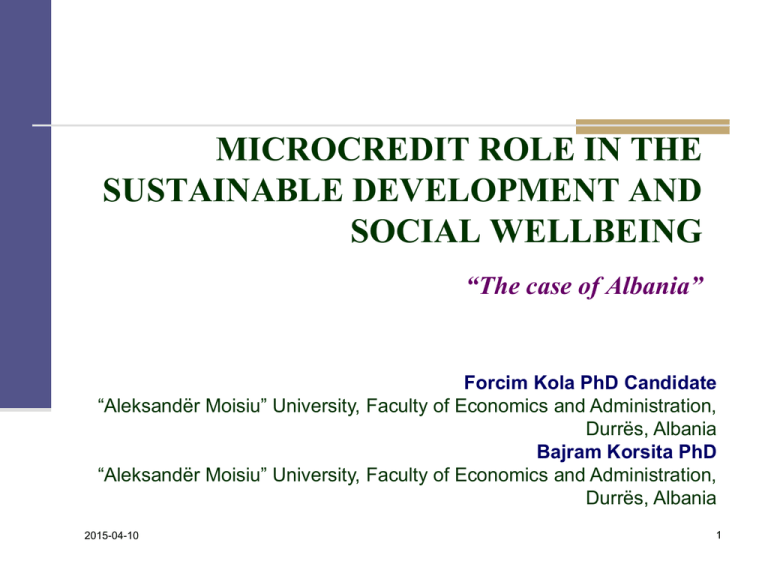
MICROCREDIT ROLE IN THE SUSTAINABLE DEVELOPMENT AND SOCIAL WELLBEING “The case of Albania” Forcim Kola PhD Candidate “Aleksandër Moisiu” University, Faculty of Economics and Administration, Durrës, Albania Bajram Korsita PhD “Aleksandër Moisiu” University, Faculty of Economics and Administration, Durrës, Albania 2015-04-10 1 MICROCREDIT ROLE IN THE SUSTAINABLE DEVELOPMENT AND SOCIAL WELLBEING “Microfinance is the supply of loans, savings, and other basic financial services to the poor.” People living in poverty, like everyone else, need a diverse range of financial instruments to run their businesses, build assets, stabilize consumption, and shield themselves against risks. Financial services needed by the poor include working capital loans, consumer credit, savings, pensions, insurance, and money transfer services. 2015-04-10 2 MICROCREDIT ROLE IN THE SUSTAINABLE DEVELOPMENT AND SOCIAL WELLBEING This research was conducted to assess impact of the Microfinance Institutions programmes (loan product), relating the investigation specifically to the following questions at the following levels of impact. Also the main objective of the Client Empowerment Research is to test the hypothesis that participation in microfinance programmes (being Microfinance Institutions clients) increases empowerment in clients. The research is aimed to help identify ways in which clients manifest empowerment as a result of their participation in the programme on the assumption that those clients who have been empowered through microfinance programme participation make decisions differently and take greater risks. 2015-04-10 3 MICROCREDIT ROLE IN THE SUSTAINABLE DEVELOPMENT AND SOCIAL WELLBEING Methodological approach The research methodology used to answer these questions was a “mid-range” impact assessment. Unlike more rigorous “academic” methodologies, mid-range methodologies explicitly accept some level of reduction in statistical validity so as to accommodate field and resource constraints and to satisfy program requirements for effectiveness and usefulness. The Client Empowerment study is also part of the qualitative research that was conducted to measure the level of Microfinance Institutions empowering clients. The clients were met and interviewed using in-depth semi-structured interviews. Clients were selected from many Microfinance Institutions branches covering almost all the territory of Albania. 2015-04-10 4 MICROCREDIT ROLE IN THE SUSTAINABLE DEVELOPMENT AND SOCIAL WELLBEING Sampling Broadly speaking, the sample was composed of the treatment group and the control group. The target population for the treatment group was “two-year clients”, and included both current and ex-clients. The distribution of current to ex-clients in the treatment group was roughly proportional to the percentage of clients who dropped out of the program over the relevant time period. The control group consisted of pipeline clients, or new program clients, who either have not received their first loan or have received their first loan but have yet finished their first loan cycle. 2015-04-10 5 MICROCREDIT ROLE IN THE SUSTAINABLE DEVELOPMENT AND SOCIAL WELLBEING Poverty Targeting The evidence shows that the Microfinance Institutions products (loans) are successfully reaching “poor” people. in % Poverty Level (Treatment Group vs. Control Group ) 80 70 60 50 40 30 20 10 0 66.67 Treat. Group % 34.57 22.22 0 7.41 Very Poor 2015-04-10 61.73 3.7 Poor Control Group % 3.7 Vulnerable Non-Poor Non-Poor Chart 1. Poverty Level as Measured by Daily per Capita Household Expenditures and Adjusted for Purchasing Power Parities—Treatment Group vs. Control Group 6 MICROCREDIT ROLE IN THE SUSTAINABLE DEVELOPMENT AND SOCIAL WELLBEING Changes in Household Income The data allow us to conclude that the treatment and control groups differ in terms of changes in household income over the last 12 months. Total % Mature Client % Ex-Client % Treatment Group % Control Group % Change in Household (HH) Income over Last 12 Months Decreased greatly Decreased Stayed the same Increased Increased greatly 4 0 0 0 4 3.70 0.00 0.00 0.00 12.90 12 2 1 3 9 11.11 3.39 5.56 3.90 29.03 25 8 2 10 15 23.15 13.56 11.11 12.99 48.39 41 33 5 38 3 37.96 55.93 27.78 49.35 9.68 26 16 10 26 0 24.07 27.12 55.56 33.77 0.00 Table 1. Change in Income over Last 12 Months—Treatment Group vs. Control Group 2015-04-10 7 MICROCREDIT ROLE IN THE SUSTAINABLE DEVELOPMENT AND SOCIAL WELLBEING Emergencies and Crises Again, there was difference in the proportion of the treatment and control group adopting any of the coping strategies to pay for unusually large or unexpected expenses. Primary coping mechanisms in control group were: loans from family and friends (19.75%), handouts from family or friends (19.75%), compared to the figures of (2.74%) and (9.59%) for the treatment group. While for the treatment group the primary coping strategies are current income (21.92%), Microfinance Institutions loan (23.29%), withdrawing savings (10.96%) compared to the figures of (4.94%), (2.47%) and (11.11%) for the control group. 2015-04-10 8 MICROCREDIT ROLE IN THE SUSTAINABLE DEVELOPMENT AND SOCIAL WELLBEING Dreams and Goals The personal dreams and goals of clients fall into two categories: i) to provide basic needs for the family, such as food, clothes, and education for the children and ii) aspirations for their family members (children) to achieve their fullest potential in society. The women interviewed expressed both dreams, while the men interviewed more often expressed the latter. For virtually all clients interviewed, their dreams and goals did not change before and after having joined the microfinance programme (being Microfinance Institutions clients). 2015-04-10 9 MICROCREDIT ROLE IN THE SUSTAINABLE DEVELOPMENT AND SOCIAL WELLBEING Perception by Household Members The general perception from the clients interviewed was that financial improvement leads to more harmonious family relations and positive feelings toward the provider in the family. As basics like food, clothing and school needs are met, family members are happier and there is more respect by family members for the provider. Interestingly, there did not seem to be differences in how male and female clients were perceived by their household. “I am the bedrock of my family” was the expression shared by five women and four men. One man indicated that “I have an important place in my family even though I am not the sole financial provider.” “Head of the house” was the expression used by three other clients, two men and one woman. 10 2015-04-10 MICROCREDIT ROLE IN THE SUSTAINABLE DEVELOPMENT AND SOCIAL WELLBEING Decision-Making about Family Issues The loans seem to have had more of an impact on the married female clients who were able to start their own businesses because of the loans. As income earners, they are now more involved in the decision making process for issues such as schooling for children and healthcare, than they were before. Four of the men indicated they were still the head of the household and the decision maker for household affairs, even though they were not the sole bread-winner of the family. 2015-04-10 11 MICROCREDIT ROLE IN THE SUSTAINABLE DEVELOPMENT AND SOCIAL WELLBEING Job Creation The difference in the average number of full-time employees between the treatment group and control group is statistically significant. Job Creation (Number of Full-Time Employees) 100 in % 80 76.92 60 31.88 19.23 40 20 Treat. Group % 46.38 5.8 Control Group % 15.94 3.85 0 0 0 1 2 3 Number of Full-Time Employees 2015-04-10 Chart 2. Job Creation: Number of Full-Time Employees 12 MICROCREDIT ROLE IN THE SUSTAINABLE DEVELOPMENT AND SOCIAL WELLBEING The number of part-time new jobs created by treatment group compared to control group was as; for 0 jobs (14.93% vs. 75.00%), 1 job (35.82% vs. 17.86%) and 2 jobs (49.25% vs. 7.14%) as according to Table 3. Number of Employees 0 1 2 Total % Mature Clients % ExClients % Treatme nt Group % Control Group % 31 9 1 10 21 32.63 18.00 5.88 14.93 75.00 29 20 4 24 5 30.53 40.00 23.53 35.82 17.86 35 21 12 33 2 36.84 42.00 70.59 49.25 7.14 Table 3. Job Creation: Number of Part-Time Employees 2015-04-10 13 MICROCREDIT ROLE IN THE SUSTAINABLE DEVELOPMENT AND SOCIAL WELLBEING Self-Esteem Several of the clients had pre-existing businesses with insufficient inventory and were unable to satisfy their customers’ demands. Two of the male clients interviewed were unable to find work and became self-employed out of necessity. This is particularly true for the women who were previously unemployed. Their new livelihood has helped them become more motivated about business, i.e. creating higher profit margins for themselves by minimizing cost and/ or maximizing revenue, as well as given them an opportunity to manage an endeavor of their own. 2015-04-10 14 MICROCREDIT ROLE IN THE SUSTAINABLE DEVELOPMENT AND SOCIAL WELLBEING Client Satisfaction The level of overall client satisfaction is higher for the current and ex-client groups than for control group (4.4 vs. 3.3). 4.3 3.2 4.4 4.4 4.2 3 3.4 3.3 Treat. Group % Overall Staff and management Control Group % Savings policies 5 4 3 2 1 0 Loan products and policies Scores Mean Client Satisfaction Scores (Treatment Group vs. Control Group ) Indicators of Client Satisfaction Key: 1=Very dissatisfied; 2=Dissatisfied; 3=No opinion; 4=Satisfied; 5=Very satisfied 2015-04-10 Chart 3. Mean Client Satisfaction Scores—Treatment Group vs. Control Group 15 MICROCREDIT ROLE IN THE SUSTAINABLE DEVELOPMENT AND SOCIAL WELLBEING Participation and Leadership Several clients were active in their communities before receiving loans, regardless of their employment situation, and have continued with their activities. Indicator of Empowerment Amount spent on schooling for children Amount spent on food Amount saved How to spend Microfinance loans Total % Mature Clients% ExClients % Treatment Group % Control Group % 2.7 3.1 2.8 3.0 1.9 23.98 24.96 23.10 24.34 25.86 3.0 3.2 3.2 3.2 1.7 26.38 25.50 27.14 26.05 23.05 2.8 3.1 2.9 3.0 1.8 24.63 24.96 24.56 24.80 24.20 2.8 3.0 3.0 3.0 2 25.02 24.58 25.20 24.80 26.89 Key: 1=Husband only; 2=Mostly husband; 3=Husband and wife equally; 4=Mostly wife; 5=Wife only 16 2015-04-10 Table 4. Intra-Household Decision Making—Treatment and Control Group MICROCREDIT ROLE IN THE SUSTAINABLE DEVELOPMENT AND SOCIAL WELLBEING An woman expressed that the loan enabled her to help her immediate community, her friends and neighbors, and in this way “improved” her standing among them, although she also indicated that her neighbors would have done the same for her family in times of need. The other three women agreed that this kind of sharing/ welfare was practiced with their neighbors as well. A group of three men interviewed together, who had businesses before joining the Microfinance Institutions, said their participation in the community was the services their businesses provide. One, a mechanic, said “Everyone needs me. If I am absent, the whole community would be affected.” 2015-04-10 17 MICROCREDIT ROLE IN THE SUSTAINABLE DEVELOPMENT AND SOCIAL WELLBEING Conclusion The responses provided during the client interviews seem to indicate that empowerment, as expressed by increased confidence in one’s abilities to be a provider for the family, a successful entrepreneur and a productive member of the community, is more evident among clients who have participated in the microfinance programme for over 24 months. However, loan impact has not been identical for all clients. The impact on self-confidence and empowerment seems to be greater for those who were unemployed or had relatively poor business activity before receiving loans from the company and for whom the loan meant a new opportunity or a significant improve in business. 2015-04-10 18 MICROCREDIT ROLE IN THE SUSTAINABLE DEVELOPMENT AND SOCIAL WELLBEING More rigorous data gathering, such as conducting further indepth studies with a larger sample, and better controlling for other external factors is necessary in order to isolate the contribution of the Microfinance Institutions loans on a client’s life. Analysis of this data would provide a more complete understanding of how and to what degree, if at all; financial services play a role in improving the standard of living and feelings of empowerment in clients. Overall, it is important that the evidence of positive impact of Microfinance Institutions products (loans) on income is viewed in combination with the broader macro-economic environment of Albania, which is improving every day. 2015-04-10 19 Thank You ! 2015-04-10 20
